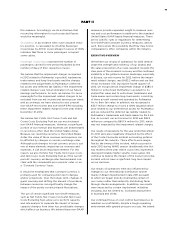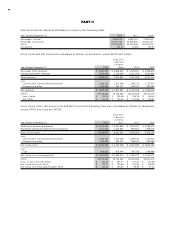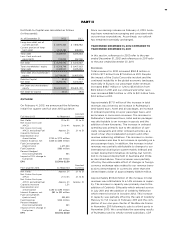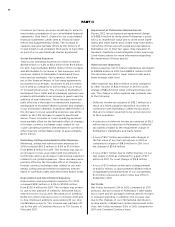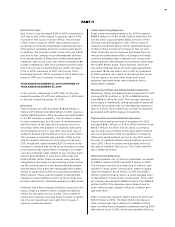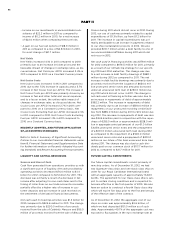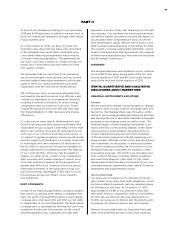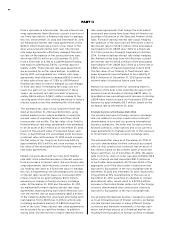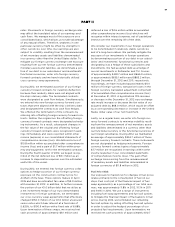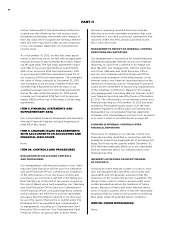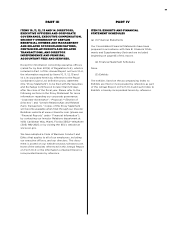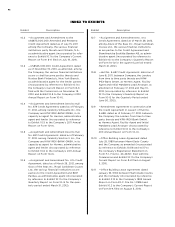Royal Caribbean Cruise Lines 2012 Annual Report Download - page 58
Download and view the complete annual report
Please find page 58 of the 2012 Royal Caribbean Cruise Lines annual report below. You can navigate through the pages in the report by either clicking on the pages listed below, or by using the keyword search tool below to find specific information within the annual report.
54
PART II
indemnify the lessor under certain circumstances.
The lessor has advised us that they believe their
characterization of the lease is correct. Based on the
foregoing and our review of available information,
we do not believe an indemnification payment is
probable. However, if the lessor loses its dispute and
we are required to indemnify the lessor, we cannot at
this time predict the impact that such an occurrence
would have on our financial condition and results
of operations.
In connection with the sale of Celebrity Mercury in
February 2011, we and TUI AG each guaranteed repay-
ment of 50% of an €180.0 million 5-year amortizing
bank loan provided to TUI Cruises. As of December
31, 2012, €153.0 million, or approximately $201.7 mil-
lion based on the exchange rate at December 31, 2012,
remains outstanding. Based on current facts and cir-
cumstances, we do not believe potential obligations
under this guarantee are probable.
TUI Cruises entered into construction agreements
with STX Finland that includes certain restrictions on
each of our and TUI AG’s ability to reduce our current
ownership interest in TUI Cruises below 37.5% through
the construction period for the first TUI newbuild
vessel. In addition, the bank credit facility agreement
for the financing of the ship extends this restriction
through 2019.
Some of the contracts that we enter into include
indemnification provisions that obligate us to make
payments to the counterparty if certain events occur.
These contingencies generally relate to changes in
taxes, increased lender capital costs and other similar
costs. The indemnification clauses are often standard
contractual terms and are entered into in the normal
course of business. There are no stated or notional
amounts included in the indemnification clauses and
we are not able to estimate the maximum potential
amount of future payments, if any, under these
indemnification clauses. We have not been required
to make any payments under such indemnification
clauses in the past and, under current circumstances,
we do not believe an indemnification obligation is
probable.
Other than the items described above, we are not
party to any other off-balance sheet arrangements,
including guarantee contracts, retained or contingent
interest, certain derivative instruments and variable
interest entities, that either have, or are reasonably
likely to have, a current or future material effect on
our financial position.
FUNDING NEEDS AND SOURCES
We have significant contractual obligations of which
the capital expenditures associated with our ship
purchases and our debt service obligations represent
our largest funding needs. We have historically relied
on a combination of cash flows provided by opera-
tions, drawdowns under our available credit facilities,
the incurrence of additional debt and/or the refinanc-
ing of our existing debt and the issuance of additional
shares of equity securities to fund these obligations.
We had a working capital deficit of $3.2 billion as of
December 31, 2012 as compared to a working capital
deficit of $2.1 billion as of December 31, 2011. Included
within our working capital deficit is $1.5 billion and
$0.6 billion of current portion of long-term debt as of
December 31, 2012 and 2011, respectively. The increase
is due to the increase in current maturities of long-term
debt. Similar to others in our industry, we operate with
a substantial working capital deficit. This deficit is
mainly attributable to the fact that, under our business
model, a vast majority of our passenger ticket receipts
are collected in advance of the applicable sailing date.
These advance passenger receipts remain a current
liability until the sailing date. The cash gener ated from
these advance receipts is used interchangeably with
cash on hand from other sources, such as our revolv-
ing credit facilities and other cash from oper ations.
The cash received as advanced receipts can be used
to fund operating expenses for the applicable future
sailing or otherwise, pay down our revolving credit
facilities, invest in long term investments or any other
use of cash. In addition, we have a relatively low-level
of accounts receivable and rapid turnover results in a
limited investment in inventories. We generate sub-
stantial cash flows from operations and our business
model, along with our unsecured revolving credit
facilities, has historically allowed us to maintain this
working capital deficit and still meet our operating,
investing and financing needs. We expect that we will
continue to have working capital deficits in the future.
As of December 31, 2012, we have approximately $8.5
billion in long-term debt obligations, of which approx-
imately $2.5 billion is due through January 2014. Also,
we have approximately $894.0 million in contractual
obligations, other than long-term debt, due through
December 31, 2013. We expect to fund these obliga-
tions through our existing liquidity, future financing
arrangements and cash flows from operations. As of
December 31, 2012, our liquidity was $2.2 billion, con-
sisting of approximately $194.9 million in cash and
cash equivalents and $2.0 billion available under our
unsecured credit facilities. Of the $2.0 billion available
under our unsecured credit facilities, $1.5 billion is
from revolving credit facilities and €365.0 million (or
$0.5 billion based on the exchange rate at December
31, 2012) is from an unsecured Euro-denominated
term loan facility. We have the ability to draw on the
€365.0 million facility at any time on or prior to June
30, 2013. During 2013, it is likely we will secure addi-
tional liquidity in the capital and/or credit markets



